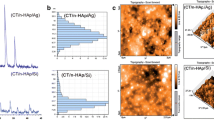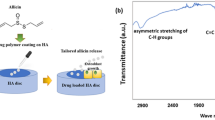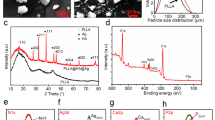Abstract
Bone tissue scaffolds based on bioactive polymer–hydroxyapatite composites have caused infections that seriously limit their extended application. In this study, we proposed a practical ion substitution method to synthesize in situ silver phosphate on the surface of a two-level, three-dimensional chitosan/nano-hydroxyapatite scaffold. A release test of silver ions in a phosphate buffered saline (PBS) solution was performed to demonstrate that silver ions were released continuously from the silver phosphate during the initial 6 days of the study. The antibacterial property and cytocompatibility of the scaffolds treated with different concentrations of silver nitrate solution were assessed by in vitro assays with Escherichia coli and MC3T3-E1, respectively. The ability of the silver-containing scaffolds to induce bacteriostasis was confirmed by the inhibition zone (15 mm) and high bactericidal rate (>99 %). Cell proliferation, morphology and the alkaline phosphatase activity of MC3T3-E1 cultured on the scaffold with low silver phosphate contents were comparable with those cultured on control samples.
抽象
本文设计了一种具有生物相容性同时又具有抗菌功能的骨组织工程支架材料。通过离子交换,在壳聚糖/纳米羟基磷灰石三维多孔支架材料表面置换了一层磷酸银,由于银离子的缓释作用,这种支架材料具有良好的长期抗菌性能。本文构建了一种具有抗菌性和良好生物相容性的三维多孔壳聚糖/纳米羟基磷灰石骨组织工程支架材料。










Similar content being viewed by others
References
Mourino V, Boccaccini AR (2010) Bone tissue engineering therapeutics: controlled drug delivery in three-dimensional scaffolds. J R Soc Interface 7:209–227
Goessler UR, Stern-Straeter J, Riedel K et al (2007) Tissue engineering in head and neck reconstructive surgery: what type of tissue do we need? Eur Arch Oto-Rhino-Laryn 264:1343–1356
Lee SH, Shin H (2007) Matrices and scaffolds for delivery of bioactive molecules in bone and cartilage tissue engineering. Adv Drug Deliv Rev 59:339–359
Bran GM, Stern-Straeter J, Hormann K et al (2008) Apoptosis in bone for tissue engineering. Arch Med Res 39:467–482
Hutmacher DW (2000) Scaffolds in tissue engineering bone and cartilage. Biomaterials 21:2529–2543
Ma M, Zhang B, Lu WP et al (2014) Preparation, thermal stability and biocompatibility studies of gelatin-induced hydroxyapatite co-substituted with essential physiological trace elements. Chin Sci Bull 59:606–615
Gristina AG (1987) Biomaterial-centered infection-microbial adhesion versus tissue integration. Science 237:1588–1595
Shah SR, Kurtis KF, Mikos AG (2013) Perspectives on the prevention and treatment of infection for orthopedic tissue engineering applications. Chin Sci Bull 58:4342–4348
Hendriks JGE, van Horn JR, van der Mei HC et al (2004) Backgrounds of antibiotic-loaded bone cement and prosthesis-related infection. Biomaterials 25:545–556
Rezwan K, Chen QZ, Blaker JJ et al (2006) Biodegradable and bioactive porous polymer/inorganic composite scaffolds for bone tissue engineering. Biomaterials 27:3413–3431
Jiranek WA, Hanssen AD, Greenwald AS (2006) Antibiotic-loaded bone cement for infection prophylaxis in total joint replacement. J Bone Joint Surg Am 88A:2487–2500
Simchi A, Tamjid E, Pishbin F et al (2011) Recent progress in inorganic and composite coatings with bactericidal capability for orthopaedic applications. Nanomed Nanotechnol Biol Med 7:22–39
Hench LL, Wilson J (1984) Surface-active biomaterials. Science 226:630–636
Wang GC, Zheng L, Zhao HS et al (2011) Construction of a fluorescent nanostructured chitosan–hydroxyapatite scaffold by nanocrystallon induced biomimetic mineralization and its cell biocompatibility. ACS Appl Mater Interfaces 3:1692–1701
Wang GC, Zheng L, Zhao HS et al (2011) In vitro assessment of the differentiation potential of bone marrow-derived mesenchymal stem cells on genipin–chitosan conjugation scaffold with surface hydroxyapatite nanostructure for bone tissue engineering. Tissue Eng Pt A 17:1341–1349
Lucke M, Schmidmaier G, Sadoni S et al (2003) Gentamicin coating of metallic implants reduces implant-related osteomyelitis in rats. Bone 32:521–531
Campbell AA, Song L, Li XS et al (2000) Development, characterization, and anti-microbial efficacy of hydroxyapatite–chlorhexidine coatings produced by surface-induced mineralization. J Biomed Mater Res 53:400–407
Alt V, Bitschnau A, Osterling J et al (2006) The effects of combined gentamicin–hydroxyapatite coating for cementless joint prostheses on the reduction of infection rates in a rabbit infection prophylaxis model. Biomaterials 27:4627–4634
Feng QL, Kim TN, Wu J et al (1998) Antibacterial effects of Ag-HAp thin films on alumina substrates. Thin Solid Films 335:214–219
Nablo BJ, Prichard HL, Butler RD et al (2005) Inhibition of implant-associated infections via nitric oxide release. Biomaterials 26:6984–6990
Yuan WY, Ji J, Fu JH et al (2008) A facile method to construct hybrid multilayered films as a strong and multifunctional antibacterial coating. J Biomed Mater Res B 85B:556–563
Hetrick EM, Schoenfisch MH (2006) Reducing implant-related infections: active release strategies. Chem Soc Rev 35:780–789
Bologna RA, Tu LM, Polansky M et al (1999) Hydrogel/silver ion-coated urinary catheter reduces nosocomial urinary tract infection rates in intensive care unit patients: a multicenter study. Urology 54:982–987
Chaloupka K, Malam Y, Seifalian AM (2010) Nanosilver as a new generation of nanoproduct in biomedical applications. Trends Biotechnol 28:580–588
Silver S (2003) Bacterial silver resistance: molecular biology and uses and misuses of silver compounds. FEMS Microbiol Rev 27:341–353
Chen X, Schluesener HJ (2008) Nanosilver: a nanoproduct in medical application. Toxicol Lett 176:1–12
Luo SH, **ao W, Wei XJ et al (2010) In vitro evaluation of cytotoxicity of silver-containing borate bioactive glass. J Biomed Mater Res B 95B:441–448
Furno F, Morley KS, Wong B et al (2004) Silver nanoparticles and polymeric medical devices: a new approach to prevention of infection. J Antimicrob Chemother 54:1019–1024
Chen W, Oh S, Ong AP et al (2007) Antibacterial and osteogenic properties hydroxyapatite coatings produced using of silver-containing a sol gel process. J Biomed Mater Res A 82A:899–906
Rameshbabu N, Kumar TSS, Prabhakar TG et al (2007) Antibacterial nanosized silver substituted hydroxyapatite: synthesis and characterization. J Biomed Mater Res A 80A:581–591
Takeuchi Y, Arai H (1990) Removal of coexisting Pb2+, Cu2+ and Cd2+ Ions from water by addition of hydroxyapatite powder. J Chem Eng Jpn 23:75–80
Babu R, Zhang JY, Beckman EJ et al (2006) Antimicrobial activities of silver used as a polymerization catalyst for a wound-healing matrix. Biomaterials 27:4304–4314
Chen LM, Zheng L, Lv YH et al (2010) Chemical assembly of silver nanoparticles on stainless steel for antimicrobial applications. Surf Coat Technol 204:3871–3875
Ikarashi Y, Tsuchiya T, Nakamura A (2000) Effect of heat treatment of poly(l-lactide) on the response of osteoblast-like MC3T3-E1 cells. Biomaterials 21:1259–1267
He H, Li Y, Zhang XL et al (2010) Precipitable silver compound catalysts for the selective catalytic reduction of NO x by ethanol. Appl Catal A Gen 375:258–264
Fathi MH, Hanifi A, Mortazavi V (2008) Preparation and bioactivity evaluation of bone-like hydroxyapatite nanopowder. J Mater Process Technol 202:536–542
Yang CR, Wang YJ, Chen XF (2012) Preparation and evaluation of biomimetric nano-hydroxyapatite-based composite scaffolds for bone-tissue engineering. Chin Sci Bull 57:2787–2792
Helander IM, Nurmiaho-Lassila EL, Ahvenainen R et al (2001) Chitosan disrupts the barrier properties of the outer membrane of Gram-negative bacteria. Int J Food Microbiol 71:235–244
Yamanaka M, Hara K, Kudo J (2005) Bactericidal actions of a silver ion solution on Escherichia coli, studied by energy-filtering transmission electron microscopy and proteomic analysis. Appl Environ Microbiol 71:7589–7593
Jung WK, Koo HC, Kim KW et al (2008) Antibacterial activity and mechanism of action of the silver ion in Staphylococcus aureus and Escherichia coli. Appl Environ Microbiol 74:2171–2178
Shrivastava S, Bera T, Roy A et al (2007) Characterization of enhanced antibacterial effects of novel silver nanoparticles. Nanotechnology 18:225103
Carman ML, Estes TG, Feinberg AW et al (2006) Engineered antifouling microtopographies-correlating wettability with cell attachment. Biofouling 22:11–21
Rivera-Gil P, Yang F, Thomas H et al (2011) Development of an assay based on cell counting with quantum dot labels for comparing cell adhesion within cocultures. Nano Today 6:20–27
Quarles LD, Yohay DA, Lever LW et al (1992) Distinct proliferative and differentiated stages of murine Mc3t3-E1 cells in culture: an in vitro model of osteoblast development. J Bone Miner Res 7:683–692
Wu S, Liu X, Gao C (2015) Role of adsorbed proteins on hydroxyapatite-coated titanium in osteoblast adhesion and osteogenic differentiation. Sci Bull 60:691–700
**ng ZC, Chae WP, Baek JY et al (2010) In vitro assessment of antibacterial activity and cytocompatibility of silver-containing PHBV nanofibrous scaffolds for tissue engineering. Biomacromolecules 11:1248–1253
AshaRani PV, Mun GL, Hande MP et al (2009) Cytotoxicity and genotoxicity of silver nanoparticles in human cells. ACS Nano 3:279–290
Acknowledgments
This work was supported by the National Natural Science Foundation of China (51372142, 51321091) and the Fundamental Research Funds of Shandong University (2014QY003-09).
Conflict of interest
The authors declare that they have no conflict of interest.
Author information
Authors and Affiliations
Corresponding authors
Electronic supplementary material
Below is the link to the electronic supplementary material.
About this article
Cite this article
Qiao, Y., Zhai, Z., Chen, L. et al. Cytocompatible 3D chitosan/hydroxyapatite composites endowed with antibacterial properties: toward a self-sterilized bone tissue engineering scaffold. Sci. Bull. 60, 1193–1202 (2015). https://doi.org/10.1007/s11434-015-0838-4
Received:
Accepted:
Published:
Issue Date:
DOI: https://doi.org/10.1007/s11434-015-0838-4




